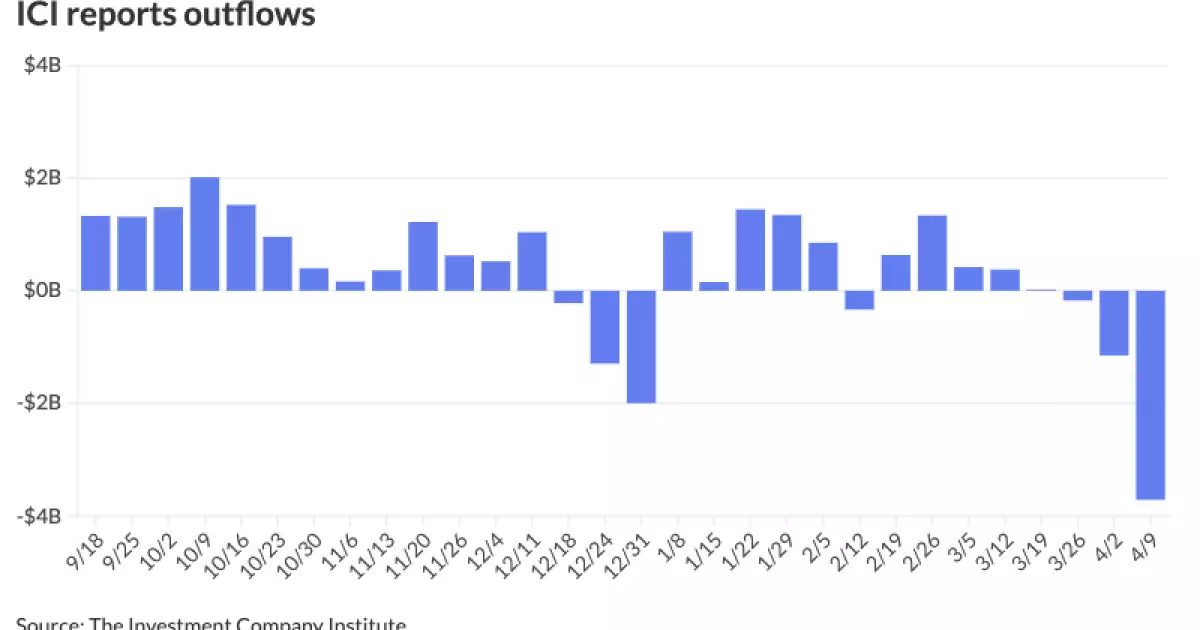In recent weeks, the municipal bond market has shown signs of stabilizing after experiencing significant volatility that rocked both investors and analysts alike. The turbulence began to subside as U.S. Treasury yields fell, accompanied by a notable sell-off in equities. Notably, the municipal bond market is currently observing an interesting trend: the two-year and five-year ratios nudging up to about 80% and 81%, respectively. As volatility diminishes, one could argue that the market is on the cusp of recovery; however, I remain skeptical. The pressures that spurred the recent outflows and investor hesitance haven’t fully dissipated and will likely resurface if market conditions shift once again.
The recent data released by the Investment Company Institute (ICI) highlighted a staggering outflow of $3.714 billion, following the $1.15 billion outflow of the previous week. While three days of slight gains may be heralded as a sign of positivity by some, it could merely be a deceptive mirage in a market that is still beneath a veneer of instability. The fluctuating dynamics of the current market should not be ignored, especially in light of the significant outflows from exchange-traded funds in previous weeks.
Yield Dislocation: An Opportunity or Deception?
The ever-changing landscape of municipal bonds raises questions about yield dislocations that some analysts, such as Kim Olsan from NewSquare Capital, are striving to interpret as a savvy buying opportunity. While the pursuit of returns in a fluctuating environment can yield benefits for astute investors, it is crucial to scrutinize whether these newfound yields present sustainable opportunities or trap investors in precarious positions. Municipal activity appears to be lifting slightly, with competitive sales from high-rated issuers such as North Carolina and Anne Arundel County drawing strong interest, resulting in yields barely deviating from AAA benchmarks. Yet, this fleeting firmness may be misleading.
The impending issuance of significant credits, such as those from Connecticut and Massachusetts, speaks to an encouraging influx that could further test the underlying strength of the market. Are investors genuinely optimistic, or is this optimism a collective result of hope amidst uncertainty? The reality remains that the recent average daily trading volume of $12 billion pales in comparison to equivalent years, a stark reminder that many buyers are still tentatively dipping their toes rather than plunging into the depths of investment.
A Cautionary Tale: Analyzing The Yield Landscape
As April 15, the tax deadline, approaches, the implications for yields are profound. Ultra-short yields have indeed adjusted dramatically, with one-year AAA MMD yields spiking to 3.45%, a far cry from their prior levels. This spike raises critical questions concerning investor behavior during tax season—are buyers overreacting, or is this simply a natural adjustment? With the one-year rates aiming at maintaining levels above 3.00%, the tax equivalent yield for top-bracket buyers gives an attractive footing at 5.00%. Nevertheless, such heights can be deceiving.
Furthermore, the advent of heavy issuance in the coming weeks, coupled with historical trends revealing high-grade bonds outpacing lower-rated credits, indicates a more significant shift towards safety. The five-year ratios climbing to around 80%, as opposed to the lows recorded last year, reflect a growing preference for safer assets among cautious investors, which could indicate deeper systemic issues rather than mere market normalcy.
Moving forward, the real test lies in whether this newfound stability will inspire confidence across the spectrum, from municipal issuances to retail investors. The current draw of high-grade bonds, alongside the continuous divergence in yield performance, necessitates careful reflection. Will this trend continue to engender security, or are we facing another round of volatility that could unnerve even the most composed investors?
The political undertones embedded within the financial narrative around municipal bonds cannot be ignored either. As municipalities grapple with funding, amid societal pressures and financial constraints, the bond market’s performance will undoubtedly function as both an economic barometer and a political tool. The future of the municipal bond landscape will hinge upon the confluence of these dynamics, demanding that investors exercise both prudence and boldness in their decision-making. The choices made today will echo in time, reflecting our collective fiscal priorities and values as we navigate this turbulent terrain.

